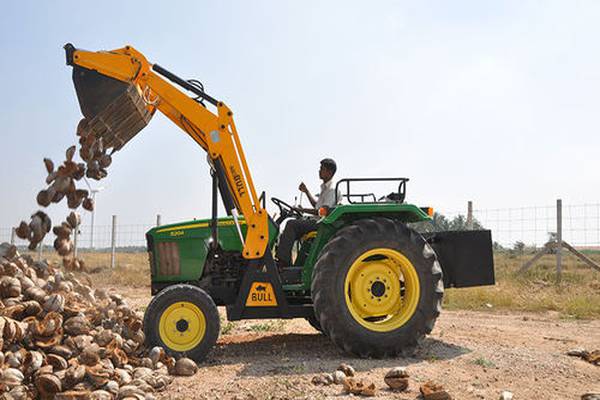Unloading Equipment In Agriculture
Drafted by: vijaychourey26@gmail.com
In the dynamic world of agriculture, efficiency and productivity are vital for success. The unloading of harvested crops is a crucial stage in the farming process. In this article, we will explore the significance of unloading equipment in agriculture and how modern technology has revolutionized this aspect of farming. By streamlining unloading processes, farmers can save time, reduce labor costs, and ensure the quality of their produce. Let's dive into the various types of unloading equipment available and how they contribute to making agriculture more efficient and profitable.
Understanding The Importance Of Unloading Equipment
The Role of Unloading in Agricultural Operations
The unloading process is a critical link between harvesting and storage. Efficient unloading equipment ensures that crops are safely and swiftly transferred from harvesting machines to storage facilities. This minimizes the risk of spoilage and damage, preserving the value of the harvest.
Impact on Farm Productivity
Well-designed unloading equipment significantly improves farm productivity. It reduces downtime during harvesting, allowing farmers to handle larger volumes of crops in shorter periods. Enhanced productivity directly translates to increased profits for farmers.
Types Of Unloading Equipment
Conveyor Belts
Conveyor belts are commonly used in agriculture for unloading purposes. They offer a smooth and continuous transfer of crops from the harvester to storage or transport vehicles. Conveyor belts are versatile and can be adjusted to different heights and angles, accommodating various farm layouts.
Grain Augers
Grain augers, also known as screw conveyors, are widely used for unloading grains, seeds, and other small crops. They are particularly useful when transferring materials over short distances and can be easily moved to different locations on the farm.
Hydraulic Dump Carts
Hydraulic dump carts are valuable unloading equipment for bulkier crops such as root vegetables and fruits. They use hydraulic systems to lift and dump the harvested produce into trucks or storage areas, reducing the need for manual labor.
Pneumatic Unloaders
Pneumatic unloaders utilize air pressure to move crops from the harvester to the storage bins. They are suitable for handling delicate crops and can unload grains without damaging them.
Benefits Of Modern Unloading Equipment
Time Efficiency
Modern unloading equipment is designed to work swiftly, saving valuable time during the harvesting process. This allows farmers to maximize their harvest and minimize labor hours.
Labor Cost Reduction
With the mechanization of unloading processes, there is a reduced reliance on manual labor. Farmers can save on labor costs, allocate human resources to other essential tasks, and even tackle labor shortages during peak seasons.
Preserving Crop Quality
Gentle handling and controlled transfer provided by modern unloading equipment ensure that the crops maintain their quality and freshness. This reduces spoilage and post-harvest losses.
Flexibility and Adaptability
Modern unloading equipment is versatile and can be adjusted to accommodate various types of crops. Farmers can easily switch between different crops without the need for extensive modifications.
Versatility in Various Crops
Unloaders can handle various types of crops, making them suitable for diverse agricultural operations. This flexibility allows farmers to utilize the same equipment for different crops.
Environmental Benefits
The adoption of unloaders leads to lower fuel consumption, reduced emissions, and a smaller carbon footprint, contributing to a more sustainable and eco-friendly agricultural sector.
Challenges And Limitations
Initial Investment Costs
The initial purchase cost of unloader machines can be substantial, making it a significant investment for small-scale farmers.
Technical Knowledge Requirement
Operating and maintaining unloaders may require technical expertise, which can be a barrier for some farmers who are not familiar with modern machinery.
Maintenance and Repairs
Like any mechanical equipment, unloaders require regular maintenance and occasional repairs. This adds to the operational costs and demands skilled technicians.
Compatibility Issues
Not all unloaders are suitable for every crop or storage unit. Farmers need to consider compatibility factors before investing in an unloader.
Weather and Environmental Conditions
Unloader performance can be influenced by adverse weather conditions, such as heavy rain or extreme temperatures. Farmers need to plan for contingencies during unfavorable weather.
Technological Advancements In Unloaders
Automation and Robotics
Automation and robotics have enabled the creation of self-operating unloaders, reducing the need for constant human supervision.
AI and Machine Learning Integration
Unloaders are incorporating AI and machine learning algorithms to optimize unloading efficiency and minimize crop wastage.
Remote Monitoring and Control
Modern unloaders can be monitored and controlled remotely through mobile applications or computer systems, enhancing convenience for farmers.
Sensor-Based Systems
Unloaders are equipped with various sensors that gather data on crop conditions, allowing for more accurate unloading processes.
Energy Efficiency and Sustainability
Many new unloaders are designed with energy-efficient features, reducing fuel consumption and promoting sustainable farming practices.
Future Trends In Unloader Maintenance
Predictive Maintenance
AI-powered systems can analyze data from unloaders to predict maintenance needs and prevent potential breakdowns.
Condition Monitoring
Sensors can continuously monitor the health of unloaders and identify potential issues before they escalate.
Preventive Maintenance Programs
Farmers can subscribe to preventive maintenance programs offered by manufacturers to ensure optimal performance and prolong the lifespan of unloaders.
Software and App-Based Solutions
Specialized software and mobile apps may be developed to provide farmers with insights, troubleshooting tips, and maintenance schedules for their unloaders.
Expert Assistance and Support
Manufacturers may offer remote expert assistance and support to farmers, enabling quick resolution of technical issues.
The Impact Of Unloaders On Agriculture
Increased Crop Yields and Quality
By optimizing the unloading process, unloaders help preserve the quality of crops, leading to higher yields of premium-grade produce.
Resource Optimization
Unloaders save time and labor, allowing farmers to allocate resources to other aspects of farming and agricultural management.
Labor Market Transformation
With reduced labor dependency, the agricultural labor market may witness changes in employment patterns and skill requirements.
Environmental Conservation
The adoption of unloaders contributes to sustainable agricultural practices, reducing greenhouse gas emissions and environmental impact.
Global Food Security
Efficient unloading and minimal crop wastage contribute to global food security by ensuring a stable and abundant food supply.







